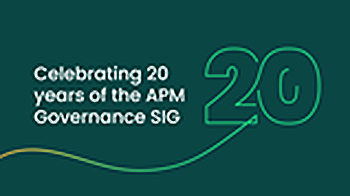20 Years of the APM Governance Specific Interest Group
On Wednesday 29 October 2003 a group of eleven project professionals met in Oxford at the SAID Business School to discuss how OECD’s principles of corporate governance could and should apply to project governance. In 2003 Corporate Governance was a hot topic after the collapse of WorldCom and Enron in the US and the fraud and bankruptcy of the Mirror Group Newspapers earlier in the 90s in the UK. The US and UK took widely different approaches. The UK through its Combined Code for Corporate Governance adopted a ‘comply or explain’ approach and the US through its Sarbanes-Oxley Act put in place a prescriptive mandatory regime.
With corporate governance biased towards ‘business as usual’ operations, the group agreed that the relationship between the temporary project organisation and the permanent corporate organisation(s) that projects belong to needed strengthening. It also needed to address the contrasting approaches depending on the governance code that has jurisdiction of the corporate body. Chaired by David Shannon, those present established what would become APM’s Governance Specific Interest Group (SIG) with the aim to “influence directors and others to adopt excellent practices regarding programmes and significant projects. This involves aligning the interests of directors, of programme and project teams and of wider stakeholders”.
A year later in 2004 the SIG published its first guide, Directing Change, aimed at the Board of Directors or those who report to the Board. The second edition of the guide was developed in collaboration with the Institute of Directors with a joint foreword by their respective leaders – the Director General of the Institute of Directors (IoD) and the APM’s Chair. The co-signatories on the guide reflected the outward looking approach the SIG established with a focus on outreach to non-project folk such as directors, company secretaries, legal counsel and regulators.
The collaboration with the IoD extended beyond the guide and included a joint conference and several joint branch events. The project community learned the principles and history of corporate governance dating back to the first incorporated businesses (17th Century tea clippers) and the directors and business leaders leaned about the need for ‘additional governance arrangements’ to empower project leaders and hold them to account. In 2015 the SIG delved deeper into the past when it held a joint event with the British Library to celebrate the 800 year anniversary of the Magna Carta, exploring how the ‘deal’ to separate power and accountability between the crown, landowners, citizens and those elected to represent them is reflected in modern governance arrangements.
Since Directing Change was first published the SIG has continued to review and update it to reflect the latest developments in both corporate governance and the world of project management. Now in its third edition it is joined by supplementary guidance on the governance of co-owned projects, the governance of agile projects and the role of the sponsor in sponsoring change.
As Chair, David Shannon passed the baton to Martin Samphire who likewise passed it to Andy Murray. With an outreach focus the three Chairs have been supported by a committed group of volunteers to achieve the influence it set out at the inaugural meeting. Several of those who attended that meeting continued to be involved with the SIG until only recently and all three Chairs past and present thank them for their great contribution. The influence from the Governance SIG guides is evident in how they have been cited by the BSI, National Audit Office, the Infrastructure & Projects Authority, HM Treasury and numerous project organisations such as Network Rail Transport for London in their reports, standards and guides.
The aim of Governance SIG has not fundamentally changed since that inaugural meeting and the publication of its first guide. The SIG and its publications continue to focus on the interface between the world of projects and the world of corporate governance. The next chapter of the SIG (as the APM transitions to communities of interest) is likely to be an exciting and important one as governance is increasingly in the spotlight whether to improve how projects align to their organisation’s ESG priorities and commitments (e.g. Net Zero or nature net gain), safeguarding stakeholder or shareholder interests, addressing the pace of disruptive change (e.g. Generative AI) or to improve public confidence in the value we gain from projects. As we know….. when projects succeed, society succeeds.
This article appears on the APM news and blog site as "Celebrating 20 Years of the APM’s Governance Specific Interest Group" dated October 29, 2023.
--Association for Project Management
[edit] Related articles on Designing Buildings
- Association for Project Management articles
- Draft environment (principles and governance) bill.
- GDPR.
- Governance.
- Governance for Railway Investment Projects (GRIP).
- Governance risks.
- Governance statement.
- Government Construction Strategy.
- Procurement.
- Public procurement.
- Public project.
- Risk.
- Risk management.
- The construction playbook.
- The green book.
- Types of risk.
Featured articles and news
Key points for construction at a glance with industry reactions.
Functionality, visibility and sustainability
The simpler approach to specification.
Architects, architecture, buildings, and inspiration in film
The close ties between makers and the movies, with our long list of suggested viewing.
SELECT three-point plan for action issued to MSPs
Call for Scottish regulation, green skills and recognition of electrotechnical industry as part of a manifesto for Scottish Parliamentary elections.
UCEM becomes the University of the Built Environment
Major milestone in its 106-year history, follows recent merger with London School of Architecture (LSE).
Professional practical experience for Architects in training
The long process to transform the nature of education and professional practical experience in the Architecture profession following recent reports.
A people-first approach to retrofit
Moving away from the destructive paradigm of fabric-first.
International Electrician Day, 10 June 2025
Celebrating the role of electrical engineers from André-Marie Amperè, today and for the future.
New guide for clients launched at Houses of Parliament
'There has never been a more important time for clients to step up and ...ask the right questions'
The impact of recycled slate tiles
Innovation across the decades.
EPC changes for existing buildings
Changes and their context as the new RdSAP methodology comes into use from 15 June.
Skills England publishes Sector skills needs assessments
Priority areas relating to the built environment highlighted and described in brief.
BSRIA HVAC Market Watch - May 2025 Edition
Heat Pump Market Outlook: Policy, Performance & Refrigerant Trends for 2025–2028.
Committing to EDI in construction with CIOB
Built Environment professional bodies deepen commitment to EDI with two new signatories: CIAT and CICES.
Government Grenfell progress report at a glance
Line by line recomendation overview, with links to more details.
An engaging and lively review of his professional life.
Sustainable heating for listed buildings
A problem that needs to be approached intelligently.
50th Golden anniversary ECA Edmundson apprentice award
Deadline for entries has been extended to Friday 27 June, so don't miss out!
CIAT at the London Festival of Architecture
Designing for Everyone: Breaking Barriers in Inclusive Architecture.
Mixed reactions to apprenticeship and skills reform 2025
A 'welcome shift' for some and a 'backwards step' for others.




























